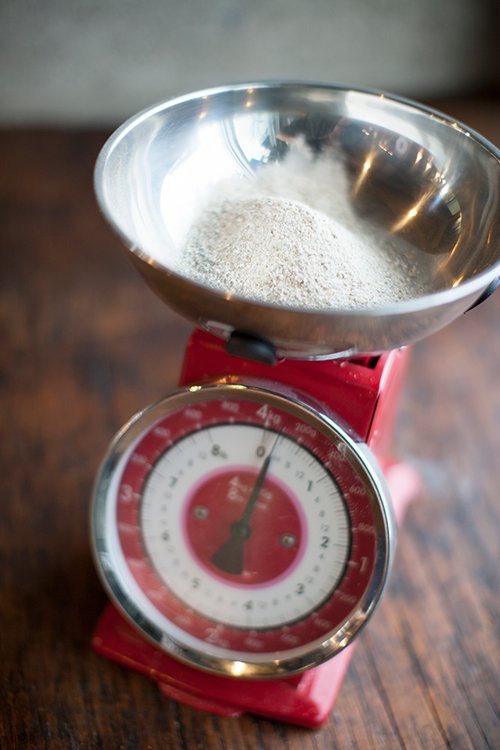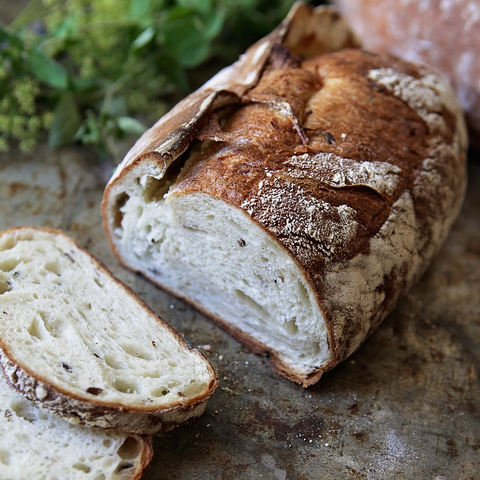
Macrina turns 25 on August 27th, and I can hardly believe it. I never imagined baking as many loaves as we do now, not to mention the pastries, cakes, and so much more. Our values have always been tied to supporting the community, so creating products made with local ingredients has always been a priority. We know where we get our food matters, so for years and years, the origin of our vegetables and meats has been a focus. In bread, however, we weren’t asking the important question: who grew the wheat? We’ve been working hard to close this gap and making the effort to learn about the farmers who grow the wheat we use. In turn, they can tell us which wheat varieties they’re growing. This makes all the difference when making artisanal, hand-formed bread. To celebrate our milestone, I’ve been creating a Macrina Anniversary Loaf, made only with grains grown and milled locally.
Local Grains

Since Macrina started in 1993, our local grain ecosystem has also come leaps and bounds. Washington is one of the largest producers of wheat in the country, and the current number of grain varietals grown in Washington State is staggering. This abundance has paved the way for specialized local mills to spring up, meeting the growing demand for freshly-milled, whole-grain flours.
At the heart of this change, just north of Seattle in the Skagit Valley, is the Bread Lab. Chief wheat breeder, Dr. Stephen Jones, runs the lab, which is an extension of Washington State University. Jones approaches the subject of locally grown wheat from every angle: with a farmer’s knowledge of the fields, a scientist’s discipline and a chef’s passion for food.
Over seven years ago, the Bread Lab invited me to be on their advisory board. Back then I had no idea how impactful it would be. For many of us on the front lines of baking, Jones has been a leading advocate for the benefits of local wheat. It has been remarkable having a front row seat to observe what they do.
Bread Lab’s Grain Gathering
Every year, the Bread Lab hosts an annual conference called Grain Gathering. Professional bakers, bread enthusiasts, brewers, farmers, and chefs from around the country gather in the Skagit Valley to talk all things bread. A few years back, Dr. Jones had a group of six of us taste a bunch of loaves mixed up by resident baker, John Bethony. Until then, I hadn’t tried a bread made entirely from whole grain milled wheat. Whole grain milled flour is usually blended with conventional flour to enhance baking, otherwise the bread tends to bake inconsistently. That wasn’t the case for the Bread Lab, where they had come up with wonderfully flavorful and beautiful loaves. It was an introduction into a whole new world.

We contrasted each loaf for taste, texture and appearance. The natural flavor of the grain blew me away. The range of flavors matched the range of wheats and each distinctive loaf tasted of the type and terroir of the wheat used. From that point forward I’ve incorporated more native wheats and whole grain flours into Macrina’s breads. It was that tasting that lit the fire for the soon to come anniversary loaf.
Anniversary Loaf: Leslie’s Gathering Process

I always have several bags of different flours open in the kitchen. They have names like T-85, Yecora Rojo, Expresso Hard Red Spring Wheat, and Skagit Magic. This is how my gathering process works. My notebooks are full of new techniques I’ve been learning. I also have bags of various locally-produced malts, oats and barley.
Baking is a mix of science, rigorous precision, intuition and feel. I’ve experimented with many variables: adding diastolic malt powder (produced locally, of course), oats and emmer, blending native wheats in varying ratios, baking earlier with longer ferments. Of course I’m using the Macrina Casera starter, the starter I created 25 years ago from champagne grapes planted in my backyard. Many of the loaves I’ve tested have had a wonderful crumb and great flavor, but they’re flatter and denser than I want. My goal is to make a voluptuous whole grain bread, one with a stunning presence as well as a stunning flavor profile.
For me, so much of baking is tactile, so it takes time. I need to feel the dough in my hands when I mix it for the first time, or after a long rise. I’m inching closer and closer, and will keep working until it is just right.
Stay tuned…

















